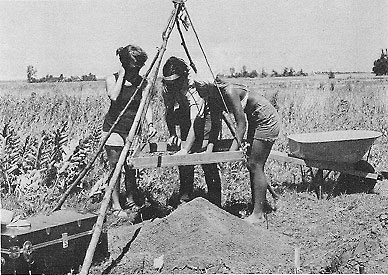Archaeologist to tell of NAL site findings

Ann Early (L.), leader of NAL summer archaeological "dig", leads group in sifting the artifacts. With her are Bill Kneip and Pam Eskey. Note trunk at left side of photo for safe-keeping of their "finds." Photo by Tony Frelo, NAL.
In a former Kane County cornfield, not far from the main parking lot at the Central Laboratory, is a site that has been marked by archaeologists as "Early Archaic - 7,000 B.C. to 4,000 B.C."
On the map of the archaeological diggers, developed under the direction of Miss Ann Early, the area is known as the "Frog Site" because the "A. Frogg Farm" was located there. It is one of the 24 sites on the NAL's 6,800 acres where evidence of early man's wanderings have been discovered after days of patient research by scholars.
In her report of 1970 activities on the NAL site. Miss Early, a graduate student at the University of Massachusetts at Amherst, observes:
"The National Accelerator Laboratory site has been occupied occasionally since approximately 7,000 B.C. Cultural material recovered from the archaeological occupations on the site demonstrates the presence of at least four major prehistoric cultural traditions at the NAL site. These range from the Early Archaic cultural tradition through the Upper Mississippian era. A later tradition, early Historic, is also represented."
Miss Early goes on to say that the extent and intensity of each of the prehistoric NAL land occupations varies considerably. The most frequent occupations occurred during the "Archaic" (7,000-4,000 B.C.) and "Upper Mississippian Langford" (1300-1600 A.D.) periods. In contrast, "Woodland" occupations (2,500 B.C.-500 A.D.) are small in number; they are restricted to certain areas of the NAL property and represent brief trips for hunting or nutgathering from larger, more permanent settlements found along the banks of larger rivers in Illinois.
During the spring and summer of 1970, a small team of archaeologists, including Miss Early, surveyed the NAL property for evidence of Indian cultures. All were from Northwestern University and were students of Prof. Stuart Struever.
Their initial report noted that "our attention was first drawn to NAL because several employees had discovered arrowheads and other chipped stone tools which were lying in plowed fields in various areas of the site. This material was evidence that at some time in the past, groups of Indians had once visited, and perhaps lived on, NAL property."
During three months in the summer of 1970, walking over all of the plowed land on the NAL property, the group recorded the location of the stone tools, potsherds, and other artifacts they discovered. Twenty-four sites were located during the 1970 survey and a quantity of individual or "stray" artifacts was collected and recorded from non-site areas.
Analyzing the evidence of the oldest occupation. Miss Early states, "The most intensive Archaic activity appears to have been carried out around the small ponds in the southeast corner of the property. Evidence indicates that small groups of Archaic peoples repeatedly visited this area and established living areas around the ponds while they engaged in hunting activities and in gathering and processing plant foods."
Following a sporadic occupation during the Woodland period, the site was occupied again shortly after 1200 A.D., when members of the "Langford" culture began exploiting the area. The Langford tradition seems to have been centered in Northern Illinois, along the Illinois River, and such sites present distinct types of pottery and bone and shell tools, and ways of burial. A dense oak-hickory forest which once covered the western portion of the site provided locales for a different kind of hunting and nut-gathering activity by the Langford inhabitants.
Miss Early returned to NAL early in the summer of 1971 to continue her "dig" and she had a number of young men and women working with her including: Allen and Nancy Randlov, graduate students at the University of Massachusetts; Michael Boyton, graduate student at Chico St. College, California; and David Hinterberger, Cathy Thompson, Mary Fowler, Pamela Eskey, William Kneip and Thomas Dickens.


